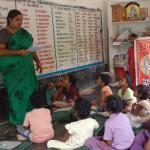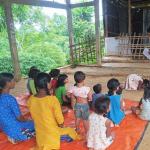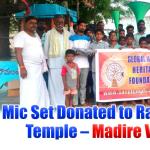Guru Purnima 2025 – Reflecting on Sadguru Sri Ganapathy Sachchidananda Swamiji
by
Prakasarao Velagapudi PhD
President, Global Hindu Heritage Foundation
Guru Purnima falls in the month of Ashadha on a very auspicious full moon day, this year on July 10, 2025. It is considered sacred, spiritual, and holy because this day is celebrated as the birthday of the great sage Vyasa. In fact, it is also called Vyasa Purnima. Sage Vyasa is respected and revered as a Guru. His contribution to the Sanatana Dharma is monumental and immense. He classified the spiritual knowledge of the Vedas into four parts: Rig Veda, Yajur Veda, Sama Veda, and Atharva Veda. He has written eighteen Puranas, describing in great detail the creation of the universe, the stories of countless saints (sages), the code of conduct, and eternal values for the benefit of humanity. He also wrote the Mahabharata, the largest epic book known to mankind, describing the stories of the Pandavas, the Kauravas, and Lord Krishna for the benefit of humanity.
Guru Purnima is the day to remember the countless blessings our countless Gurus have showered on mankind. It is my privilege and honor to discuss the concept of the Guru, the importance of the Guru, Guru Purnima, and Paduka Puja.
On this day, let us remember Sri Ganapathy Sachchidananda Swamiji, his divine personality, time-tested wisdom, boundless compassion, and his ever-watchful eye over his devotees. We are most fortunate to have Datta Prabhu as Sadguru, manifested in a physical form as Brahma, Vishnu, and Maheshwara, so that we can either perform or witness Guru Pada Puja to His Divine Personality. It is indeed a rare occasion for thousands of devotees attending Guru Purnima at the Allen Center in the Dallas area. Sri Datta Prabhu, who is the Avatara of Lord Dattatreya himself, is present in our hearts to emulate, cherish, and learn the essence of the meaning of life. He is a Sadguru only to remove the darkness, light the wick of ignorance, guide us to the right path, impart the meaning of light, bring happiness to our lives, pour the amrita (ambrosia) into the hearts of all his disciples, kindle spirituality, impart knowledge to follow the path of self-knowledge, transform the troubled lives and create peaceful sanctuaries across the globe.
Sri Datta Prabhu has been trekking the world for over six decades, bestowing his unconditional compassion, absolute grace, and unrestricted love across the globe. His commitment to spread the wisdom of Bhagavad Gita, emulating the children to learn Bhgavad Git for the last ten years, purify Panchabhutas with numerous Maha Yagnas, organizing meditation camps to benefit innumerable, countless devotees, maintaining one of a kind the bird sanctuary, managing the largest Bonsai Garden in Asia and transforming the countless people. He received 15 Guinness World Records to exemplify the diversity of His talents and conducted hundreds of Healing and Meditation concerts across the globe. As a Guru and Sadguru, he has been advising, prodding, guiding, counseling, chiding, and molding the personalities of his devotees. Whether in physical presence or in a subtle formlessness, he connects with his devotees to help them remove obstacles, and with infinite shakti, he assists many of his devotees. In many ways, he is a father figure, an ideal hero, a spiritual giant, a religious champion, an inspirational conqueror, and a personification of divinity.
As a precursor to 2025 Guru Purnima, Datta Prabhu was awarded another Guinness World Record for conducting the Largest Carnatic Band on July 9, 2025 at Allen Event Center around 9:00pm in Allen Texas.
For times immemorial, the Guru has played a very significant role in the Hindu tradition. On Guru Purnima Day, we worship, adore, and revere our Guru. In fact, all of us have gathered here to express our gratitude to our beloved Datta Prabhu, revered as the embodiment of truth and wisdom. We want to express our appreciation to Datta Prabhu, who graciously agreed to bless all the USA devotees, particularly those in Dallas, by celebrating Guru Purnima. This is also the day for all the devotees to introspect on the spiritual progress they have made, remember their past experiences, resolve to follow Sri Datta Prabhu’s message of goodness and godliness, aspire to do more seva for his mission, and determine to follow the path of God realization and seek His countless blessings.
Who is a Guru?
Datta Prabhu is a Sadguru who not only removes the darkness of ignorance by imparting the eternal values of life to his devotees but also instills spiritual knowledge, provides guidance in the day-to-day mundane life, offers strength to face problems, and inspires us to traverse the path to God realization. Countless devotees of Sri Swamiji have experienced innumerable miracles in their lives. He is always with us and within us, touching our lives, directing our future, and providing indescribable happiness to His devotees. His presence is always felt.
Listen to what Kabir has to say about Guru:
It is the mercy of my true Guru that has made me know the unknown;
I have learned from Him how to walk without feet, to see without eyes,
to hear without ears, to drink without mouth, to fly without wings;
I have brought my love and my meditation into the land where
there is no sun and moon, nor day and night.
Without eating, I have tasted the sweetness of nectar.
and without water, I have quenched my thirst.
“The Guru is great beyond words, and great is good fortune of the disciple.”
Tukaram talks about the significance:
Without the Sadguru, all talk of liberation is the whispering of ghosts.
Vyas, other sages, and scriptures, too, sing the glory of the Master.
Consider the one without a Guru as ever in mourning.
Do not even glance at his face.
No efforts will ever liberate him from birth and death.
Know that his human life will go to waste.
Holy books have stated thus, O Tuka,
And thus, have declared all Saints in the past.
How do you know that Datta Prabhu influenced you or touched you? Whether you are a first timer or a lifelong devotee, in his presence, you experience happiness, satisfaction, delightfulness, pleasure, bliss, joy, peace in your own mind because you are in the company of the holiest of holy saints. When you come to the source, you will undoubtedly experience joy and peace. Seeds of bhakti, love, righteousness, goodness, and godliness are sown in your mind. You will see tremendous change in yourself as these seeds are planted over the years in your life. You might ask, “How do I know that I am in the presence of a Sadguru?” In fact, the Upanishads list five signs of experiencing a Sadguru: knowledge flourishes (Gnana raksha); sorrow diminishes (Duhkha kshaya); joy wells up without any reason (Sukha aavirbhava); abundance dawns (Samriddhi); all talents manifest (Sarva samvardhan).
DO WE NEED A GURU?
All the Gods, sages, saints, prophets, incarnations, and great spiritual leaders had Gurus. Gurus taught them wisdom, protected them from impending danger, and guided them to pursue the proper path. Then the question is, “Do I need a Guru or a Sadguru?” There is no question about it. Svetaketu learned from Uddalaka; Maitreyi from Yagnavalkya; Bhrugu from Varuna; Narada from Sanatkumara; Nachiketu from Yama; Indra from Prajapati; Lord Rama from Vasishta; Arjuna from Lord Krishna, Lord Krishna from Sandeepani; all the Devas from Brihaspati; Sankaracharya from Govindapada; Vivekananda from Rama Krishana Parama Hamsa; and many Divine beings from Dakshina Murthy, the silent teacher.
Lord Shiva Himself emphasizes the importance of and need for a Guru. Lord Shiva Himself reveals to Maheswari (Parvati) that without a Sadguru, there is no liberation. If you have any inclination for Moksha, there is no better time than now to accept Datta Prabhu as your Guru. Spiritual progress, happiness, bliss, and life satisfaction are achieved only through the grace of the Sadguru. Life is short. Life is confusing. It is beset with numerous problems. Problems can overwhelm you, confound you, confront you, and constrict you. Practice Dharma. Burn your karmas and achieve progress. Let Datta Swami’s Padukas be your saviors and help you realize your Real Self and achieve Moksha in this life. With the blessings of Datta Prabhu, is it possible to achieve your goal of self-realization in this life only? Take Him to your heart, imprint His image in your heart’s chamber, construct a Temple for His Holiness in your heart, and worship His image. Then, let Him guide you, mold you, protect you, and direct you to the desired goal of self-realization.
One who is very much interested and serious about understanding spiritual life needs a guru. One who is longing to know the nature and purpose of life, who is interested in knowing God, who truly wants to understand the relationship between God and the Guru, and who is serious about spiritual growth, requires a guru. Don't approach a guru with a skeptical mind, and don’t go to a guru to test them. You will not learn. It is useless. Don’t go to a Guru because somebody else is going. Try to have as little knowledge as possible before meeting a Guru. Until you know the value of Gold, it means nothing. It is like any other piece of metal. Until you know the value of a Guru, you can’t appreciate him. That means we must go with a positive, curious, inquisitive, and surrendered mind. The Shastras state that we must go to the gurus and surrender to them. Without surrendering, you cannot learn anything. If you want to challenge a guru, it is not possible to learn. All the scriptures also say that if you surrender to a bona fide guru, you are, in effect, surrendering to God.
Hence, a true guru is one whose mere presence brings about a deep transformation. Sri Swamiji is not a mere teacher; He is an awakener. His voice, more than words, serves as a vehicle to lasting inner bliss, and His presence instills a state of calmness. Sri Swamiji, being a Supreme Personality and firmly grounded in the Datta lineage, enables us to trace our roots and helps us to retrieve and reestablish our identification with Divinity.
Without Sadguru, there is no spiritual progress; there is no release from cycles of death and rebirth, and no freedom from the bondage to the world of karma and suffering. In the Guru Gita, Shiva says to Parvati that:
There is nothing greater than the guru; there is nothing greater than the guru; there is nothing greater than the guru; there is nothing greater than the guru!
This is ordained by Shiva; this is ordained by Shiva; this is ordained by Shiva; this is ordained by Shiva!
If Shiva is offended, the guru will grant redemption;
If the guru is offended, who can grant redemption?
Guru Pada Puja on Guru Purnima Day
In fact, we all know that Bharata ruled Ayodhya by worshipping and seeking guidance from the Sandals blessed by Lord Rama. These Padukas ruled the kingdom. Many saints have discussed the virtues of Paduka Puja and even built Temples. Sri Narasimha Saraswathi, the second Avatara of Lord Dattatreya, lived his last 12 years in Ganakapur under an Audumbara tree. When he decided to leave his body, he promised the villagers that he would leave his Padukas there, and he would be ever present, and their wishes would be granted if his Padukas were worshipped. Similarly, the Padukas of Sri Pada Vallabha, the first incarnation of Lord Dattatreya, are worshipped in Pittapuram. Sri Ganapathy Sachchidananda Swamiji built Paduka Kshetram in Gudivada.
It is customary to perform Pada Puja to the Lotus Feet of a living Sadguru on Guru Purnima. It is indeed a rare opportunity for a disciple to participate in such a Pada Puja. Why is to so important to perform Pada Puja? The Guru’s Feet are worshiped because all of the Guru’s Shakti dwells in the Feet. The vibrations of the inner self constantly flow out through the Feet. The nerves that originate from the Sahasrara extend down to the Feet. The Feet serve as the support for the whole body. This is the reason the Feet are given so much importance. More shakti flows from the Feet than from any other part of the body.
Samartha Ramadas highlights the importance of the guru, stating that “without the grace of the Guru, one cannot realize the Self; contemplation and concentration, devotion and worship, would be all useless without the grace of the Guru.” The Guru uplifts the world’s knowledge and virtues, becoming an exemplary force for life, devotion, and understanding. Ramadasa clarifies that such lived examples of a guru’s existence should be reflective as wisdom, dispassionateness, devotion, sadhana, rightful conduct, spiritual awareness, mindfulness, morality, and justice, and the observation of the meaning constitutes the characteristic foundation of a guru.
Kularnava Tantra says: “The Guru’s feet are worshipped or revered because all the Guru’s shakti dwells in the feet. If you did research into this, you would find that the vibrations of the inner self constantly flow out through the feet. The nerves that come from the Sahasrara reach right down to the feet. The feet serve as support for the whole body. This is the reason the feet are given so much importance. More shakti flows from the feet than any other part of the body; the glory of the Guru’s feet for the Guru’s sandals is great.”
“Remember the Guru’s Sandals …They provide protection against great diseases, great disturbances, great evils, great fears, great calamities, and great sins.”
to all the scriptures, the Foot of the Guru is no ordinary Foot. Gurupaddangre paadodakam ganga. All holy waters, including Mother Ganga, live in the Guru’s Feet. All holy waters, all Devatas, or angels, and all sacred hills abide in the Guru’s Feet. One should have firm faith to behold all gods in the Guru’s Feet. The Trimurti – Brahma, Vishnu, and Siva – live in Guru’s Feet. So, after Guru Pada Puja, it is very important to surrender yourself to the Divine Trinity along with all the bad habits and selfish ego. This is the significance of self-surrender to the Guru’s Feet. Especially on Guru Purnima Day, Pada Puja assumes even greater importance, as it bestows numerous blessings, peace of mind, and mental satisfaction.
The Paduka Panchaka also mentions that the Guru’s feet are cool like the nectar of the moon. In other words, just as the moonbeams cool us off after the heat of the day, in the same way, devotion to the feet of the Guru extinguishes the fire of sorrow and suffering and gives us peace.
“To obtain knowledge and detachment, sip the water of Guru’s feet, which destroys ignorance and ends karmas, the cause of rebirth. Muktananda says it is not the water of the Guru’s physical feet that will make you immortal; it is only the nectar flowing in the Guru’s abode situated in the Sahasrara that will make you immortal, and that nectar can be received by the grace of the Guru.” (Verse 14).
In the words of the Maharashtrian poet-saint, Eknath. “By the dust of my Guru’s feet, all the work was accomplished. Eknath has emerged his mind in Shri Guru’s feet… By holding the feet of the Guru, all ignorance disappeared. I have not performed cruel austerities, offered sacrifices, or wandered to sacred places. The means of all means is the feet of the Sadguru.”
All divinities, all sacred knowledge, everything of worth in the entire universe, are known to reside in the feet of a Guru. ‘Great is this lore of the Sadguru’s feet, because those who embrace them with full devotion are freed from all sins, their accumulated past life karmas are burnt away, so that they are able to realize worldly desires and can even attain spiritual liberation.’ Sant Kabir says,
“Those who become entranced by a single crescent of the Guru’s toenail
Are blessed to effortlessly attain full knowledge of the Vedas
The saint poet Meera, devotee of Shri Krishna sings,
I am obsessed by the vision of the guru’s feet. Nothing but the guru’s feet satisfies any longer; the world is only a dream illusion.
How would a devotee celebrate Guru Purnima?
A devotee should have firm, steadfast, and unwavering faith in Datta Prabhu. He knows his devotees through and through, the past, present, and future. He knows what is best for His devotees. Therefore on the day of Guru Purnima, we all need to remember the greatness of Datta Prabhu, his silent teachings, his profound speeches, and his subtle insightful message; we should look back and see how he touched our lives, we should introspect and see what kind of changes he brought in us to grow spiritually, and resolve ourselves to offer our prayers in recognition of his everlasting imprints on our personality and show our reverence to our Sadguru in mind, action, and speech. Let us be grateful for his constant vigil and continuous protection. It is time for us to acknowledge his redemptive attributes and praise his glory.
It is difficult for us as devotees to pay the debt to our Sadguru Sri Swamiji for all the blessings he showered, the grace he pours, the guidance he provides, the peace of mind he delivers, and the shelter he hovers for all of us.
As we celebrate the Guru Purnima on this day, let us remember the eternal message of expressing our gratitude as stated by Sant Jnaneswar:
[The devotee] regards the Guru as a holy place, his deity, mother, and father, and knows no other path than service to him.
It is the joy of his life to live in his Guru’s house, and he loves others who serve the Guru as his own brothers.
The repetition of the Guru’s name is his only prayer, and his only scripture is his Guru’s words.
For him, the water that touches his Guru’s feet embraces all the holy places in the three worlds.
O Arjuna, he would take a speck of the dust raised by his Guru’s feet as the price with which to obtain eternal joy.
What more can I say? His devotion is boundless. Out of overpowering inspiration, I have described it in this way.
Jnanadev says, my soul takes delight in serving my Guru. This is why I have explained it in such detail.
Otherwise, if I am not occupied in serving him, I am helpless even though I have hands, I am blind to worship even though I have eyes, and I am less able than a lame man to walk around the temple.
I am mute in praising his glory even though I have a voice, … Yet in my heart, I have the sincere desire to serve him.
LET US ALL HAVE A SINCERE DESIRE TO SERVE OUR SADGURU SRI SWAMIJI. Let us express our gratitude to our Datta Prabhu for his compassion, caring guidance, and loving support, which have provided us with the strength to face the troubles and tribulations of these times. He has also maintained a constant vigil to protect his devotees – that is, all of us.
10 Jul 2025















 Urgent support needed for Bangladesh Hindus
Urgent support needed for Bangladesh Hindus 



